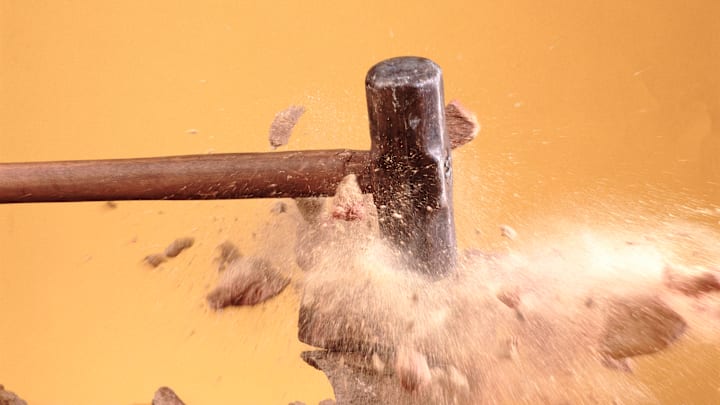There are dozens of different home improvement television shows with a multitude of hosts, but all of them have one thing in common: At some point, someone is going to pick up a giant sledgehammer and bash in a wall.
This handy tool makes it possible to repair and restore by first destroying and decimating, its blunt-force head capable of turning drywall into dust and outdated countertops and cabinets into rubble; mafia goons have surely wielded them to trash small business shops who refuse their overtures to pay protection money. It was also the title of an ’80s spoof cop show and a popular Peter Gabriel song. But why is it called a “sledgehammer”?
A Striking Impression
According to the Oxford English Dictionary, before there was sledgehammer there was simply sledge, “a large, heavy hammer usually wielded with both hands, especially the large hammer used by a blacksmith.” The word or variations thereof have written mentions dating to the 14th century and can be found in Old English (slecg), Dutch and Danish (slegge), Old Norse (sleggja), and Swedish (slägga).
The OED states the stem of sledge is derived from obsolete uses of slay, which meant “to smite, strike or beat” or “to deal a blow or blows.”
Tragically, slayhammer didn’t happen. Sledgehammer was instead adopted circa the 15th century, with the OED citing its first printed use in 1495. Mentions of the word were few and far between until it saw a spike in the late 1800s. A verb sense of the word popped up in the mid-1830s.
The etymological mystery here is why sledge became sledgehammer in the first place: When using it, you’re redundantly saying “hammer hammer.” The OED doesn’t have any explanation. One could infer that as people wound down use of sledge, hammer was added for clarification. It’s also possible sledge could have been misconstrued for any kind of hammer, while sledgehammer was able to denote a powerful tool that could inflict maximum damage. Or sledgehammer could be just one of many English words that exemplify the language’s redundancies used for emphasis.
Taking a Sledgehammer to It
Sledgehammer’s reputation as the killing machine of tools eventually resulted in a figurative usage: When a response appears to be out of proportion to a problem and will likely cause more harm than good, one is said to be “taking a sledgehammer to it.”
“It would be like taking a sledgehammer to kill a fly on a man’s face,” one editorial in an 1848 edition of the Kennebec Journal read. “The fly would escape and the man [would] be knocked down.” (Actually, that man would almost certainly be catastrophically injured or dead, but the point is understood.)
In the UK, Australia, and New Zealand, some use the phrase using a sledgehammer to crack a nut—a solution that far exceeds the exertion needed. One might, for example, use a sledgehammer to drive a nail, but that would be taking a sledgehammer to it, both literally and figuratively.
Getting the Right Hammer for the Job
So when should you use a sledgehammer? When you’re an HGTV host, obviously. But also when you want to drive a wedge to split firewood or to try and straighten metal. You can also use them to drive posts, though some recommend a similar tool called a “post maul” for that. Similar to a sledgehammer, they’re typically made of wood with a larger, rounder head. For smaller jobs, an “engineer’s hammer”—12 to 18 inches in length and weighing just a few pounds—might be best.
Hammer Type | Description | What It’s Used For |
|---|---|---|
Claw Hammer | Common carpenter’s hammer with a V-shaped neck, known as the claw | Driving and removing nails |
Ball Peen Hammer | One rounded end | Metalworking; driving rivets into steel |
Sledgehammer | Large, heavy tool with dual blunt ends | Teardown jobs; driving fence posts |
Engineer’s Hammer | Smaller (12–18 inch) sledgehammer | Demolition jobs |
Rubber Mallet | Clawless mallet with a rubber head to minimize damage to object being struck | Driving stakes; landscaping |
Post Maul | Similar to a sledgehammer with a larger, flatter head | Driving fence posts with minimal damage |
Get Answers to More Pressing Questions About Tools:
